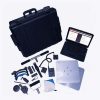
4 Ways To Use Sonography in Rehab
Treatment GuidelinesImaging plays an essential role in treating soft-tissue injuries. The challenge is obtaining an accurate image without facing excessively high costs or expenses. By working with sonography, you can reduce the risks to a patient and improves the treatment process.
What is sonography?
Sonography is a medical practice using sound to create an image or an effect in the body of an individual. It may also be called ultrasound, but this differs slightly. A sonogram is the image generated by the sound, while the ultrasound refers to the sound waves created by the machine to generate the image.
Sonographers use an ultrasound machine to create an image that helps professionals identify the underlying problems causing the pain a patient may experience from their injuries. For example, doctors can use sonography to identify strokes, or to examine patients at high risk for a stroke.
Sonography works effectively for soft-tissue injuries or similar complications. Let’s explore four ways sonography can benefit your practice.
1. Efficient imaging
A key reason that OTs and PTs may prefer sonography is the efficiency of the procedure. The sonogram, or image, is generated quickly by using an ultrasound machine and a gel to conduct sound through the specific area of the body.
After the sound bounces back to the machine, a professional can examine the image to determine the cause of the patient’s pain. It does not take time to develop an image, which allows the professional to get efficient results and start working on a treatment plan immediately.
2. Get images in real time
While efficiency is essential for the image, it is not the only factor that sets sonography apart from other imaging options. An ultrasound provides a real-time image rather than a snapshot taken at a specific time.
By using a real-time image, a clinician can follow changes in the body and identify problems without worrying about the underlying concern shifting or moving.
For example, a Doppler ultrasound can show images of red blood cells and blood flow around the body. Because it shows a live view, it can also detect blood clots that may complicate treatment. This means you can detect problems before they cause complication, and ultimately make treatment safer for the patient.
3. Cut healthcare costs
Sonography is a relatively low-cost option for imaging. Unlike traditional imaging and MRIs, the cost of sonography is more reasonable. It cuts back on the expenses associated with evaluation and diagnosis.
This low-cost imaging ensures effective treatment without wasting funds. That can enable patients to consider a longer treatment plan when limitations in their insurance policy may complicate the therapy.
Having a sonogram in your clinic can help you avoid sending the patient to different facilities for imaging and diagnosis. Your patients will appreciate getting everything they need from one location.
4. Reduce inflammation
Although ultrasound and sonography are primarily imaging devices, they can also play a role in rehab therapy. The therapist may use sound to encourage soft-tissue healing by reducing the inflammation in a specific area of the body.
The way ultrasound works in treatment is by gently heating specific location in the body. The sound waves generate a mild warming as the sound bounces off structures in the body. The increased blood flow to the area reduces inflammation, which may help with pain management.
Improving treatment practices
Sonography enables PTs and OTs to identify causes of pain, treat soft-tissue injuries, and avoid the dangers of blood clots. As an imaging option, it’s cost-effective and provide accurate results quickly.
With real-time imaging and diagnosis capabilities, sonography improves the overall treatment process. By taking using more efficient techniques, clinical professionals can create a better experience for their patients.





